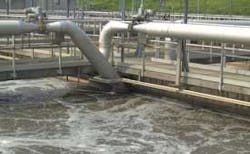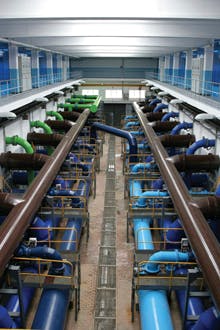SCADA & Remote Monitoring: The Advantages of Implementing Wireless I/O
by Dan Paladino
Historically, hardwiring was the only option for users to connect remote instrumentation. New technology enabling use of spread spectrum radio makes it possible to connect remote instrumentation without need of a costly wired infrastructure. With the prospect of being able to solve virtually any remote monitoring or control application, the industry is beginning to view wireless input/output (I/O) as an innovation for addressing issues previously deemed cost prohibitive, not technically feasible or lacking in reliability.
What is Wireless I/O?
Wireless I/O is a mechanism by which analog (4-20 mA, 1-5 VDC, etc.), discrete and other raw signals are transmitted via radio to and from central processing devices, such as a programmable logic controller (PLC) or remote terminal unit (RTU). Data transmitted includes level, pressure, flow, temperature, alarms and signals generated to actuate final control elements, such as valves.
In simplest terms, wireless I/O is wire replacement, where a wireless communication link emulates wire in an application. No changes are required to the system architecture. Rather, wireless links are used to transmit data that physical wire once carried. Consider a level transmitter connected by a twisted pair of wires to a control system. Wireless I/O replaces the twisted pair as the physical layer carrying the analog pressure data to the control system.
In Figure 1, which illustrates a typical tank level installation using wireless I/O, the cable is removed and a transmitter is connected to an analog input of the wireless I/O slave device. A wireless I/O master is connected to the control system’s analog input. The control system and instruments do not recognize a difference in wired or wireless.
Remote control functionality also may be utilized using wireless I/O. In Figure 1, the tank level is monitored using a single analog input on the wireless I/O slave radio. A wireless I/O master and I/O slave are used with logic written in the control system where the level is monitored. Once the tank reaches a defined low level, the control system generates a digital output to open a valve and allow the tank to be filled. In Figure 2, the only modification is connecting the valve to the digital output of the I/O slave.
Why Go Wireless?
Frequently, geographically scattered assets and sensor data is needed back at a central point. Previously available options include: trenching, running conduit and pulling wire to remote locations. Wireless I/O offers substantial and measurable cost savings in terms of engineering, installation and logistics as well as dramatic improvements in the frequency and reliability of data collection.
Many wireless I/O applications offer cost effective measurement of monitoring points to eliminate manual collection of data, thereby improving labor productivity. In more sophisticated applications, a central processing device and wireless I/O enable users to extract diagnostic data and predictive intelligence from devices that then notify personnel of issues before costly errors occur.
As a result, wireless I/O is used to reduce expenditures. The majority of wireless I/O systems deployed are used for data acquisition, but users increasingly utilize wireless I/O in control applications as well (see Figure 2). Today, the conventional thinking has shifted from hardwiring to using wireless I/O to create reliable, robust supervisory control and data acquisition (SCADA) networks.
Frequency Hopping
The foundation of wireless I/O is license-free 900MHz spread spectrum radio technology specifically designed for integration into remote assets and SCADA systems. This technology has been widely used in water and wastewater facilities for close to 20 years and has proven very reliable.
Unlike fixed frequency radio, frequency-hopping spread spectrum (FHSS) radios pseudo-randomly vary carrier frequency, quickly hopping through multiple channels while sending data. Interference is avoided by hopping over different frequencies, each of which has a different interference effect or characteristic. This provides FHSS with collision-free access by allocating a specific time slot and frequency for its transmission. A frequency-hopping scheme, combined with error detection and automatic repeat requests ensures the data is delivered reliably.
Advantages Over Wired
The most intuitive advantage of wireless I/O is a reduction of labor and material costs required to hardwire remote assets. Installation costs are a growing concern for company managers as labor rates continue to rise.
Added savings are realized via speed of deployment. Wired systems can take days or weeks to be properly installed. Wireless I/O networks generally require only the end points to be installed, saving substantial time and costs. Networks should scale gracefully as the number of end-points increases. Following installation savings, scalability is the biggest advantage of wireless I/O over hardwire.
Deploying additional points in a wireless I/O network is incremental. Instead of installing more I/O slaves, slaves may share a common I/O master. Capacity is increased by installing more I/O slaves. Wireless I/O can be implemented slowly, over time and actually integrate into these existing systems.
Conclusion
Wirelessly enabled I/O solutions offer an opportunity to turn information into knowledge, resulting in optimized productivity. As the advantages defined above illustrate, wireless I/O is positioned to meet specific challenges beyond just wiring costs. Shedding wires provides unmatched freedom and flexibility to creatively solve difficult challenges and allows adopters to deliver a major, positive impact to their respective company’s bottom line.
About the Author: Dan Paladino works in business development for FreeWave Technologies Inc., in Boulder, CO. With over 10 years experience in the wireless industry, Paladino has been a business owner, vice president, national sales manager. His responsibilities with FreeWave include overseeing water applications for the company’s radios, growing OEM business opportunities and expansion of certain international markets. Contact: 303-249-4558 or [email protected]




